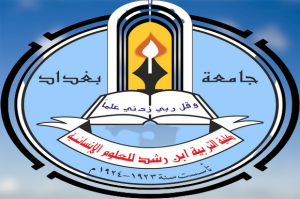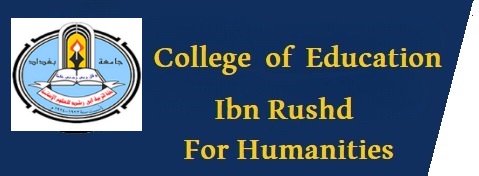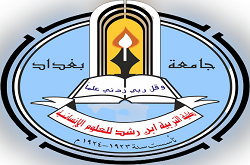About College

A Historical Overview of the College of Education, Ibn Rushd for Human Sciences.
The College of Education has kept up with the education development in Iraq throughout its long journey. It was first established under the “Higher Teachers’ House” in November 1923 (1341 AH) when the Ministry of Education proposed its establishment to the Council of Ministers. This initiative was driven by the need for teachers to develop secondary education. The college was initially divided into the Department of Natural Sciences and Human Sciences Department. Later, a Department of Mathematics was added. The college accepted graduates from the Primary Teachers’ House and secondary school graduates.
The classes were held in the evening, and each student was required to pay a fee of 15 rupees per month, equivalent to 1 dinar and 125 fils. Evening classes continued until 1929, when the schedule was changed to daytime classes. A dormitory was also added, and the college accepted secondary school graduates or their equivalents for a two-year program funded by the government. Accepted students were required to sign a contract committing to serve in the Ministry of Education in a position assigned by the ministry for a period equal to the duration of their studies. During that time, Professor Talib Mushtaq, appointed principal of the Central Secondary School in 1927, served as the deputy dean and a lecturer until Dr. Naji Al-Asil was appointed the dean. At the time of its establishment, the college’s faculty comprised:
- Professor Sati’ al-Husri – Teaching Psychology, Philosophy of Science,
and Principles of Teaching
- Professor Abdul Latif al-Filahi – Teaching Arab History
- Professor Yusuf Rizqallah Ghanimah – Teaching the History of Iraqi
Civilization
- Professor Wadi’ As’ad – Teaching Economic Geography
- Professor Hashim al-Sa’di – Teaching Geography of Iraq
- Professor Wadi’ Abdul Karim – Teaching Physics
- Professor Ezzeddin Alamuddin – Teaching Chemistry and Natural History
In the following year, they were joined by:
- Dr. Naji al-Asil – Teaching History of Civilization
- Professor Ma’ruf al-Rusafi – Teaching Arabic Literature
- Professor Jalal Razeeq – Teaching Mathematics
- Professor Tahseen Ibrahim – Teaching Chemistry
- Professor Shawqi al-Wand – Teaching History of Islam
- Professor Muhammad Khurshid – Teaching English Translation
In 1931, this institution was abolished by the Ministry of Education, which believed that the level of study there was insufficient for preparing secondary school teachers. The ministry justified this decision by arguing that it was necessary to rely on graduates from foreign universities due to the low academic standards of the institution. Furthermore, the annual expenses for a student at the American University of Beirut were 1,300 rupees, approximately 9.250 dinars (nine dinars and two hundred fifty fils), which was much lower than the 1,615 rupees, equivalent to 12.125 dinars (twelve dinars and one hundred twenty-five fils), required for a student at the Higher Teachers’ College. As a result, the institution was closed in 1931 after the graduation of fourteen students from that year’s cohort of nineteen. The graduates were appointed to secondary education positions, but the urgent need for teachers and the limited number of students sent abroad revealed the flaw in this policy. This prompted the Ministry of Education to reopen the institution in 1935. The study was initially two years but was extended to three years in 1937. That same year, the institution began admitting female students, making the education coeducational. Additionally, inspection and physical education branches were established in the same year.
1939 Regulation No. 55 for the Higher Teachers’ College was issued. Article 1 of this regulation specified the purpose of establishing the Higher Teachers’ College: to prepare teachers for intermediate and secondary schools, as well as inspectors, school principals, and employees to undertake various tasks requiring expertise in education and teaching. It also aimed to offer special courses to enhance cultural knowledge and improve teachers’ proficiency. Article 2 of the regulation stated that the institute was directly linked to the Ministry of Education, with the Minister of Education as its authoritative reference. According to this regulation, the duration of the study was extended to four years.
In the academic year 1941-1942, a branch for teaching foreign languages was added to the Higher Teachers’ College. The following year, 1942-1943, the study duration was extended to five years by adding a preparatory year to prepare new students for subsequent stages. The curriculum was divided into two branches:
Humanities Branch: This included studies in Arabic, English, geography, and history.
Science Branch: This included studies in biology, physics, and mathematics.
The Higher Teachers’ College significantly contributed to the Ministry of Education by supplying many specialized teachers and staff. In the academic year 1945-1946, the study duration at the Higher Teachers’ College returned to four years and remained on this system until 1949-1950. In 1949, religious studies were introduced into the Higher Teachers’ College curriculum. As for the number of students, the enrolment figures were as follows:
In the academic year 1923-1924, 50 students were accepted. The number began to increase, reaching 86 students in 1936-1937. It continued to rise to 102 students in the academic year 1937-1938. Students increased to 654 in the academic year 1949-1950. It grew to 1,533 students in the academic year 1954-1955. By the academic year 1962-1963, the number of students had reached 1,560. Finally, students increased significantly to 3,306 in the academic year 1967-1968.
On September 30, 1958, the Higher Teachers’ College was renamed the College of Education and was affiliated with the University of Baghdad in the same year. After the issuance of Law No. 29 of 1958, which designated the primary goal of the College of Education as preparing teachers for intermediate and secondary education, Professor Kamal Ibrahim was appointed its dean.
The curriculum of the College of Education was divided into three types of studies:
Specialization Studies, including applied sciences, mathematics, social sciences, and literature.
General Cultural Studies encompassing foreign languages and contemporary issues.
Professional Studies covering education, psychology, and teaching principles.
The College of Education began awarding bachelor’s degrees, and its graduates were exempted from reserve service due to the urgent need for their services, which increased student interest in the college. The college continued to progress and expand. However, its trajectory faced obstacles and confusion after the overthrow in 1968. Subsequently, in the following academic year, 1968-1969, the College of Education was closed without clear reasons. Afterward, a two-year post-bachelor’s program was opened to prepare graduates from other colleges as teachers for intermediate and secondary schools.
Two years later, in 1974, the College of Education was reopened with a defined study period of four years. It accepted graduates from secondary education in both its scientific and literary branches and certified teachers. Graduates were awarded either a Bachelor of Arts or Bachelor of Science degree, depending on their specialization.
In 1988, the college was divided into two separate entities:
College of Education (Ibn Rushd) included departments specializing in humanities, educational sciences, and psychology.
College of Education (Ibn al-Haytham), which housed departments focused on scientific studies alongside its branch of educational sciences and psychology.
However, due to objections from the College of Education (Ibn al-Haytham) regarding this nomenclature, the first college was renamed as Ibn Rushd, and the second as Ibn al-Haytham.
In the academic year 1987-1988, postgraduate studies leading to Master’s and Doctorate degrees were introduced in the Department of Arabic Language and Literature. Additionally, a Master’s program was established in the Department of English Language, Geography, and History, with several cohorts graduating from these programs.
A branch named “Methods of Teaching Quranic Sciences” was opened in 1992-1993, and studies commenced that year. However, this branch closed in 2003 but reopened again in 2007.
The college includes seven departments:
Department of English Language
Department of Arabic Language
Department of Kurdish Language
Department of History
Department of Geography
Department of Quranic Sciences and Islamic Education
Department of Educational Sciences and Psychology

